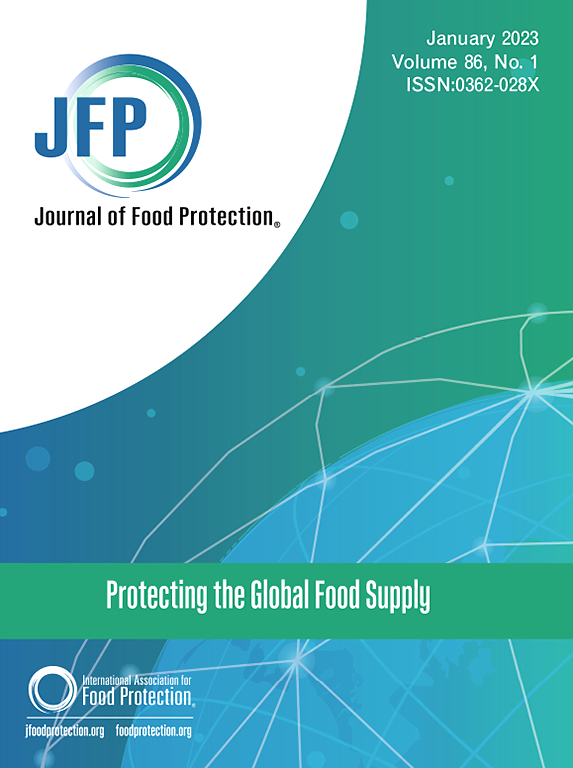Estimation of Dietary Acrylamide Exposure of Ethiopian Population Through Coffee Consumption
IF 2.1
4区 农林科学
Q3 BIOTECHNOLOGY & APPLIED MICROBIOLOGY
引用次数: 0
Abstract
This study estimated the acrylamide exposure of the Ethiopian population through traditional brewing of Coffee arabica. Acrylamide concentrations in traditionally processed Ethiopian C. arabica varieties from Jimma, Sidama, Yirgacheffe, Nekemte, and Hararge were measured. A qualitative survey in Addis Ababa was used to develop a traditional coffee brewing flowchart, which was then applied in a laboratory setting. Acrylamide concentrations in roasted coffee powders were found to be 944.01, 861.67, 739.63, 726.35, and 326.60 μg/kg for Hararge, Nekemte, Jimma, Yirgacheffe, and Sidama, respectively. First brew concentrations were 119.97, 112.10, 108.68, 94.07, and 6.67 μg/L, and second brew concentrations were 21.41, 16.45, 16.77, 3.92, and 6.31 μg/L for the respective varieties of Nekemte, Yirgachefe, Jimma, Hararge, and Sidama. Estimated daily intake (EDI) of acrylamide, based on coffee consumption data, were well below harmful levels (<200 μg/kg bw/day), with Target Hazard Quotient (THQ) values indicating minimal noncarcinogenic risk (<1). The study also found low concern for nonneoplastic effects (intake < 0.2 μg/kg bw/day) from Sidama and Nekemte coffees, although a relatively higher concern was observed for Nekemte in specific areas. The findings suggest that reducing acrylamide content in coffee through preventive actions and mitigation strategies is advisable to minimize potential health risks.
估算埃塞俄比亚人口通过饮用咖啡摄入丙烯酰胺的情况。
这项研究估计了埃塞俄比亚人通过传统的阿拉比卡咖啡冲泡接触丙烯酰胺的情况。测量了来自吉马、西达马、耶尔加舍夫、内凯特和哈拉格的传统加工埃塞俄比亚阿拉比卡咖啡品种中的丙烯酰胺浓度。在亚的斯亚贝巴进行的定性调查被用来制定传统的咖啡酿造流程图,然后在实验室环境中应用。Hararge、Nekemte、Jimma、Yirgacheffe和Sidama的烘焙咖啡粉中丙烯酰胺的浓度分别为944.01、861.67、739.63、726.35和326.60 μg/kg。Nekemte、Yirgachefe、Jimma、Hararge和Sidama的第一次冲泡浓度分别为119.97、112.10、108.68、94.07和6.67 μg/L,第二次冲泡浓度分别为21.41、16.45、16.77、3.92和6.31 μg/L。根据咖啡消费数据,丙烯酰胺的估计每日摄入量(EDI)远低于有害水平(< 200 μg/kg bw/day),目标危害商(THQ)值表明最低的非致癌风险(< 1)。该研究还发现,人们对Sidama和Nekemte咖啡的非肿瘤效应(摄入量< 0.2 μg/kg bw/day)的关注程度较低,尽管在特定区域观察到Nekemte咖啡的关注程度相对较高。研究结果表明,通过预防措施和缓解策略来减少咖啡中丙烯酰胺的含量,可以最大限度地减少潜在的健康风险。
本文章由计算机程序翻译,如有差异,请以英文原文为准。
求助全文
约1分钟内获得全文
求助全文
来源期刊

Journal of food protection
工程技术-生物工程与应用微生物
CiteScore
4.20
自引率
5.00%
发文量
296
审稿时长
2.5 months
期刊介绍:
The Journal of Food Protection® (JFP) is an international, monthly scientific journal in the English language published by the International Association for Food Protection (IAFP). JFP publishes research and review articles on all aspects of food protection and safety. Major emphases of JFP are placed on studies dealing with:
Tracking, detecting (including traditional, molecular, and real-time), inactivating, and controlling food-related hazards, including microorganisms (including antibiotic resistance), microbial (mycotoxins, seafood toxins) and non-microbial toxins (heavy metals, pesticides, veterinary drug residues, migrants from food packaging, and processing contaminants), allergens and pests (insects, rodents) in human food, pet food and animal feed throughout the food chain;
Microbiological food quality and traditional/novel methods to assay microbiological food quality;
Prevention of food-related hazards and food spoilage through food preservatives and thermal/non-thermal processes, including process validation;
Food fermentations and food-related probiotics;
Safe food handling practices during pre-harvest, harvest, post-harvest, distribution and consumption, including food safety education for retailers, foodservice, and consumers;
Risk assessments for food-related hazards;
Economic impact of food-related hazards, foodborne illness, food loss, food spoilage, and adulterated foods;
Food fraud, food authentication, food defense, and foodborne disease outbreak investigations.
 求助内容:
求助内容: 应助结果提醒方式:
应助结果提醒方式:


